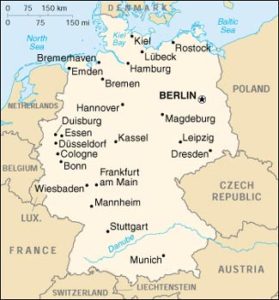
The history of the Jews in Germany goes back to the Early Middle and High Middle Ages (5th century – 1299 CE). The community survived under Charlemagne, but suffered during the Crusades. Accusations of well poisoning during the Black Death, 1346–53, led to mass slaughter of German Jews and they fled in large numbers to Poland. The Jewish communities of the cities of Mainz, Speyer and Worms became the center of Jewish life during medieval times. This was a golden age as area bishops protected the Jews resulting in increased trade and prosperity.
The legal and civic status of the Jews underwent a transformation under the Holy Roman Empire. Jewish people found a certain degree of protection with the emperor of the Holy Roman Empire, who claimed the right of possession and protection of all the Jews of the empire. A justification for this claim was that the Holy Roman Emperor was the successor of the emperor Titus, who was said to have acquired the Jews as his private property. The German emperors apparently claimed this right of possession more for the sake of taxing the Jews than of protecting them.
 The 15th century became the signal for renewed persecution of Jews. Jews in Germany remained the victims of a religious hatred that ascribed to them all possible evils. n the late 18th century, a youthful enthusiasm for new ideals of religious equality began to take hold in the western world. Austrian Emperor Joseph II was foremost in espousing these new ideals. As early as 1782, he issued the Patent of Toleration for the Jews of Lower Austria, thereby establishing civic equality for his Jewish subjects, at least in theory.
The 15th century became the signal for renewed persecution of Jews. Jews in Germany remained the victims of a religious hatred that ascribed to them all possible evils. n the late 18th century, a youthful enthusiasm for new ideals of religious equality began to take hold in the western world. Austrian Emperor Joseph II was foremost in espousing these new ideals. As early as 1782, he issued the Patent of Toleration for the Jews of Lower Austria, thereby establishing civic equality for his Jewish subjects, at least in theory.
With the abolition of differences in legal status during the Napoleonic era and its aftermath, citizenship was established as a new franchise generally applying to all former subjects of the monarchs. Prussia conferred citizenship on the Prussian Jews in 1812, though this by no means resulted in full equality with other citizens. Jewish emancipation did not eliminate all forms of discrimination against Jews. Napoleon’s fall in 1815, resulted in increasing repression. From August to October 1819, pogroms that came to be known as the Hep-Hep riots took place throughout Germany. Jewish property was destroyed, and many Jews were killed. During this time, many German states stripped Jews of their civil rights.
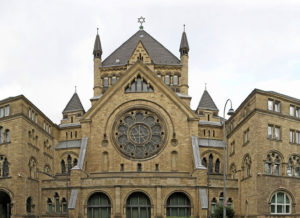 The Revolutions of 1848 swung the pendulum back towards freedom for the Jews and they experienced a period of legal equality. In 1871, with the unification of Germany by Chancellor Otto von Bismarck, came their emancipation, but the growing mood of despair among assimilated Jews was reinforced by the antisemitic penetrations of politics. The Jewish population grew from 512,000 in 1871 to 615,000 in 1910, including 79,000 recent immigrants from Russia.
The Revolutions of 1848 swung the pendulum back towards freedom for the Jews and they experienced a period of legal equality. In 1871, with the unification of Germany by Chancellor Otto von Bismarck, came their emancipation, but the growing mood of despair among assimilated Jews was reinforced by the antisemitic penetrations of politics. The Jewish population grew from 512,000 in 1871 to 615,000 in 1910, including 79,000 recent immigrants from Russia.
A higher percentage of German Jews fought in World War I than of any other ethnic, religious or political group in Germany; some 12,000 died for their country. Tsarist Russia was regarded as the oppressor in the eyes of German Jews for its pogroms, and they fought despite the unsavoury prospect fighting fellow Jews. However, this service to Germany was never acknowledged. After World War I, antisemitism grew again, during the time of the Weimar Republic and later on during the Nazi reign. For the most part, however, the prosperity and legal equality of the Jews continued unabated until Hitler’s rise to power in 1933, and the legal discrimination and violence that ensued.
In 1933, persecution of the Jews became an active Nazi policy, but at first laws were not as rigorously obeyed or as devastating as in later years. Of the 522,000 Jews living in Germany in January 1933, approximately 304,000 emigrated during the first six years of Nazi rule and about 214,000 were left on the eve of World War II. Of these, 160,000-180,000 were killed as a part of the Holocaust. On May 19, 1943, only about 20,000 Jews remained.
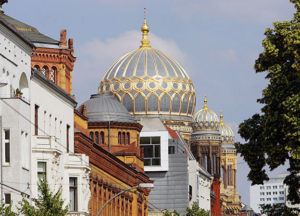 Palestine was a popular destination for German Jewish emigration. Soon after the Nazis’ rise to power in 1933, they negotiated the Haavara Agreement with Zionist authorities in Palestine, which was signed on August 25, 1933. Under its terms, 60,000 German Jews were to be allowed to emigrate to Palestine and take $100 million in assets with them. During the Fifth Aliyah, between 1929 and 1939, a total of 250,000 Jewish immigrants arrived in Palestine – more than 55,000 of them from Germany, Austria, or Bohemia. The United States was another destination for German Jews seeking to leave the country. By 1940, due to its strict immigration policy only 90,000 German Jews out of around 250,000, had been granted visas. Some 100,000 German Jews also moved to Western European countries, especially France, Belgium, and the Netherlands. However, these countries would later be occupied by Germany, and most of them would still fall victim to the Holocaust. Another 48,000 emigrated to the United Kingdom and other European countries.
Palestine was a popular destination for German Jewish emigration. Soon after the Nazis’ rise to power in 1933, they negotiated the Haavara Agreement with Zionist authorities in Palestine, which was signed on August 25, 1933. Under its terms, 60,000 German Jews were to be allowed to emigrate to Palestine and take $100 million in assets with them. During the Fifth Aliyah, between 1929 and 1939, a total of 250,000 Jewish immigrants arrived in Palestine – more than 55,000 of them from Germany, Austria, or Bohemia. The United States was another destination for German Jews seeking to leave the country. By 1940, due to its strict immigration policy only 90,000 German Jews out of around 250,000, had been granted visas. Some 100,000 German Jews also moved to Western European countries, especially France, Belgium, and the Netherlands. However, these countries would later be occupied by Germany, and most of them would still fall victim to the Holocaust. Another 48,000 emigrated to the United Kingdom and other European countries.
In the years between 1933 and 1939, the Nazi regime had brought radical and daunting social, economic, and communal change to the German Jewish community. Six years of Nazi-sponsored legislation had marginalized and disenfranchised Germany’s Jewish citizenry and had expelled Jews from the professions and from commercial life. By early 1939, only about 16 percent of Jewish breadwinners had steady employment of any kind. Thousands of Jews remained interned in concentration camps following the mass arrests in the aftermath of Kristallnacht (Night of the Broken Glass) in November 1938. Kristallnacht, raged throughout the whole of Germany during the night of 10 November 1938. During this wave of violence organized by the state against the Jews, more than 100 Jews were murdered and 30,000 Jewish men were imprisoned in concentration camps. Thousands of synagogues, Jewish shops, schools, cemeteries and hospitals were destroyed or set on fire. In the aftermath of Kristallnacht, the German government forced the Jewish community to pay for all the damages that had been inflicted on them.
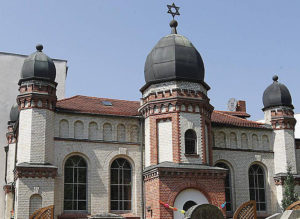 Following the outbreak of war on September 1, 1939, the government imposed new restrictions on Jews remaining in Germany. One of the first wartime ordinances imposed a strict curfew. Jews received reduced rations; limited time periods to purchase food and restricted access to stores. German authorities also demanded that Jews relinquish valuable property to local officials. In September 1941, a decree prohibited Jews from using public transportation and Jews over the age of six to wear the yellow Jewish Star on their outermost garment. German authorities issued ordinances requiring Jews fit for work to perform compulsory forced labor.
Following the outbreak of war on September 1, 1939, the government imposed new restrictions on Jews remaining in Germany. One of the first wartime ordinances imposed a strict curfew. Jews received reduced rations; limited time periods to purchase food and restricted access to stores. German authorities also demanded that Jews relinquish valuable property to local officials. In September 1941, a decree prohibited Jews from using public transportation and Jews over the age of six to wear the yellow Jewish Star on their outermost garment. German authorities issued ordinances requiring Jews fit for work to perform compulsory forced labor.
German authorities began systematic deportations of Jews from Germany in October 1941, even before the SS and police established extermination camps in German-controlled Poland. These German Jews suffered automatic confiscation of their property upon crossing the Reich frontier. In early 1943, as German authorities implemented the last major deportations of German Jews to Theresienstadt or Auschwitz, German justice authorities enacted a mass of laws and ordinances legitimizing the Reich’s seizure of their remaining property and regulating its distribution among the German population.
Although the SS used the Theresienstadt ghetto as a showcase to portray the fiction of humane treatment of Jews, it represented a way station to Auschwitz. More than 30,000 died in the Theresienstadt ghetto itself, mostly from starvation, illness, or maltreatment. By the end of the war, an estimated 160,000 to 180,000 German Jews had been killed by the Nazi regime and their collaborators.[6] A total of about six million European Jews were murdered under the direction of the Nazis, in the genocide that later came to be known as the Holocaust.
 There were a number of the righteous in Nazi Germany. Helmut Kleinicke, sheltered and helped Jewish labourers avoid deportation to death camps. Karl Plagge was a German engineer who rescued Jews in Lithuania by issuing work permits to non-essential workers. Berthold Beitz saved many of the Jewish workers there from the Nazis’ death camps, sometimes by even hiding them together with his wife at his home. Oskar Schindler used his political connections as a former German spy and his wealth to bribe Nazi officers to prevent his workers from being deported and killed. Hans Calmeyer was put in charge of a small team processing appeals from people contesting their classification as Jews under the Nazis’ Nuremberg race laws. He accepted many of these pleas, saving at least 3,000 people from deportation to concentration and extermination camps.
There were a number of the righteous in Nazi Germany. Helmut Kleinicke, sheltered and helped Jewish labourers avoid deportation to death camps. Karl Plagge was a German engineer who rescued Jews in Lithuania by issuing work permits to non-essential workers. Berthold Beitz saved many of the Jewish workers there from the Nazis’ death camps, sometimes by even hiding them together with his wife at his home. Oskar Schindler used his political connections as a former German spy and his wealth to bribe Nazi officers to prevent his workers from being deported and killed. Hans Calmeyer was put in charge of a small team processing appeals from people contesting their classification as Jews under the Nazis’ Nuremberg race laws. He accepted many of these pleas, saving at least 3,000 people from deportation to concentration and extermination camps.
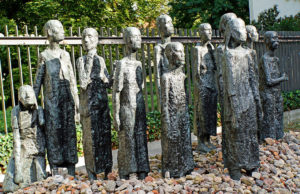 As the Allies swept to victory in Europe and camps were liberated across the once Nazi-occupied territories, the full scale of the Holocaust emerged. The Allies found camps that were catastrophically over-crowded with no food or sanitation. The living lay with their heads against the corpses and around them moved the awful ghostly procession of emaciated, aimless people with nothing to do and no hope of life. Unable to move out of your way, unable to look at the terrible sights around them. There was no privacy, nor did men or women ask it any longer. Women stood and squatted stark naked in the dust trying to wash themselves and to catch the lice on their bodies. Babies had been born here – tiny wizened things that could not live. A mother driven mad screamed at a British sentry to give her milk for her child and thrust the tiny mite into his arms and ran off crying terribly. He opened the bundle and found the baby had been dead for days.
As the Allies swept to victory in Europe and camps were liberated across the once Nazi-occupied territories, the full scale of the Holocaust emerged. The Allies found camps that were catastrophically over-crowded with no food or sanitation. The living lay with their heads against the corpses and around them moved the awful ghostly procession of emaciated, aimless people with nothing to do and no hope of life. Unable to move out of your way, unable to look at the terrible sights around them. There was no privacy, nor did men or women ask it any longer. Women stood and squatted stark naked in the dust trying to wash themselves and to catch the lice on their bodies. Babies had been born here – tiny wizened things that could not live. A mother driven mad screamed at a British sentry to give her milk for her child and thrust the tiny mite into his arms and ran off crying terribly. He opened the bundle and found the baby had been dead for days.
General Eisenhower ordered careful documentation of evidence by occupying troops as thoughts turned to justice. Hitler and other senior Nazis including Himmler and Goebbels killed themselves. In November, trials of captured Nazi leaders began at Nuremberg. The international military tribunal delivered its verdict on 21 senior Nazi officials. 18 were found guilty and three were acquitted. Eleven of Hitler’s deputies were given death sentences, including Goering, the most senior surviving Nazi. However he too committed suicide the night before he was due to hang. Others received prison terms. Albert Speer, Hitler’s personal architect, was released in 1966 and spent his remaining years writing about the Nazi regime, donating most of his royalties to Jewish charities. Rudolph Hess committed suicide in prison in 1987. Many Nazis evaded justice altogether and were never tried.
 A number of Nazis were caught by Nazi hunters and brought to justice. Adolf Eichmann was pursued by Wiesenthal before being captured and smuggled from Argentina in 1960 by the Israeli spy agency, Mossad, and was tried in Israel, after which he was executed. Klaus Barbie, the “Butcher of Lyon”, was extradited from Bolivia to France in 1983, but he had been protected by the US and German intelligence services for anti-Soviet intelligence purposes. In 1987, he was sentenced to life imprisonment. Herberts Cukurs, the “Butcher of Riga”, was assassinated by Mossad agents in Montevideo, Uruguay, in 1965. Franz Stangl, the commandant of the Sobibór and Treblinka extermination camps, was caught by Wiesenthal in São Paulo in 1967. He was extradited to Germany in 1970 and sentenced to life in prison.
A number of Nazis were caught by Nazi hunters and brought to justice. Adolf Eichmann was pursued by Wiesenthal before being captured and smuggled from Argentina in 1960 by the Israeli spy agency, Mossad, and was tried in Israel, after which he was executed. Klaus Barbie, the “Butcher of Lyon”, was extradited from Bolivia to France in 1983, but he had been protected by the US and German intelligence services for anti-Soviet intelligence purposes. In 1987, he was sentenced to life imprisonment. Herberts Cukurs, the “Butcher of Riga”, was assassinated by Mossad agents in Montevideo, Uruguay, in 1965. Franz Stangl, the commandant of the Sobibór and Treblinka extermination camps, was caught by Wiesenthal in São Paulo in 1967. He was extradited to Germany in 1970 and sentenced to life in prison.
The Holocaust essentially wiped out German Jewry. Of the roughly 565,000 Jews living in Germany in 1933, fully 94%, 528,000 people,were gone by 1950. A scant 37,000 Jewish people remained. This number decreased further as many German Jews emigrated to Israel in the 1950s. By the mid-1960s, communities were solidified in West Berlin, Munich, Frankfurt, Dusseldorf, Hamburg and Cologne consisting of about 20,000 Jews. Less than a thousand Jews lived in East Germany and those who did were concentrated in East Berlin. Other Jews unaffiliated with the established communities lived in Germany as well.
 Beginning in the late 1980s and continuing through 2004, the long-stagnant communities began to change. Huge numbers of immigrants came from the former Soviet Union. The influx of Soviet Jews revitalized community life, kosher food and restaurants, and grass-root organizations. Following the reunification of Germany in 1990, the small Jewish community of East Germany was gradually integrated into the larger German Jewish community. Today, the number of Jews in Germany is estimated to exceed 200,000, a number including non-affiliated Jews and descendants of mixed marriages. The Jewish population has become increasingly liberal. Assimilation and intermarriage remain significant social problems. In 1993 a Jewish high school in Berlin was reopened for the first time since World War II.
Beginning in the late 1980s and continuing through 2004, the long-stagnant communities began to change. Huge numbers of immigrants came from the former Soviet Union. The influx of Soviet Jews revitalized community life, kosher food and restaurants, and grass-root organizations. Following the reunification of Germany in 1990, the small Jewish community of East Germany was gradually integrated into the larger German Jewish community. Today, the number of Jews in Germany is estimated to exceed 200,000, a number including non-affiliated Jews and descendants of mixed marriages. The Jewish population has become increasingly liberal. Assimilation and intermarriage remain significant social problems. In 1993 a Jewish high school in Berlin was reopened for the first time since World War II.
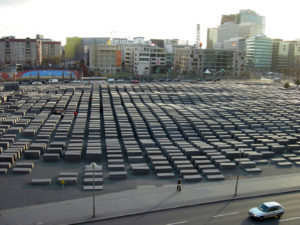 In May 2005, the Memorial to the Murdered Jews of Europe, Germany’s official Holocaust memorial museum, opened in the centre of Berlin. The memorial consists of a Field of Stelae covering an area of 19,000 square meters and containing 2,711 concrete blocks together with an information centre. Currently Berlin houses the largest concentration of Jews in Germany, with about 50,000 Jews calling the city home in 2013. Today, more than 110 synagogues are dispersed throughout Germany.
In May 2005, the Memorial to the Murdered Jews of Europe, Germany’s official Holocaust memorial museum, opened in the centre of Berlin. The memorial consists of a Field of Stelae covering an area of 19,000 square meters and containing 2,711 concrete blocks together with an information centre. Currently Berlin houses the largest concentration of Jews in Germany, with about 50,000 Jews calling the city home in 2013. Today, more than 110 synagogues are dispersed throughout Germany.
Anti-Semitism is still prevalent in Germany. On May 27, 2019, Chancellor Angela Merkel said, given its Nazi past, Germany has to be “much more vigilant that others” when it comes to nationalist movements across Europe. Merkel lamented that “there is to this day not a single synagogue, a single day care centre for Jewish children, not a single school for Jewish children that does not need to be guarded by German policemen” and admitted “over the years we have not been able to deal with this satisfactorily.” On October 9, 2019, during a Yom Kippur service, a right-wing extremist live-streamed an attack on a synagogue in the town of Halle. Unable to get through a locked door where approximately 80 worshipers were barricaded, the man killed two people nearby and later injured two others. The death toll would almost certainly have been higher if he had managed to get inside the synagogue.